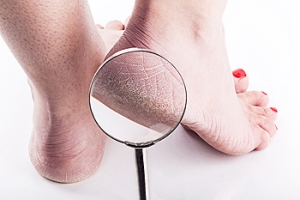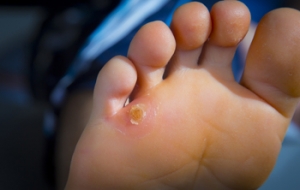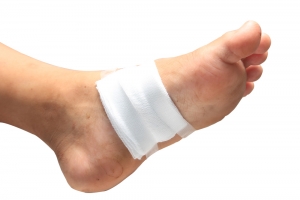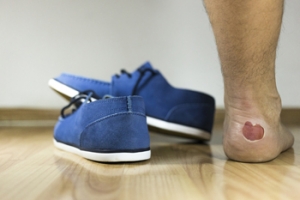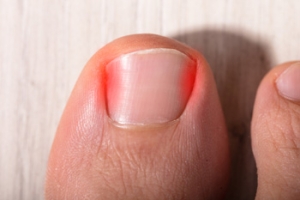Connect With Us

Treating Cracked Heels
 Cracked heels, while physically embarrassing, can also bring a great deal of discomfort and pain to the affected foot. Some common causes of cracked heels may include open-back footwear, weather, and improper skin care. To help remove the dry skin, use a filer and gently scrape the areas that are hardened. Exfoliating, washing, and thoroughly drying the feet may also be beneficial to treating cracked heels. Using a daily moisturizer can also help to ease the discomfort of cracked heels, and it keeps the skin hydrated. In order to safely treat and heal cracked feet, seek the care of your podiatrist.
Cracked heels, while physically embarrassing, can also bring a great deal of discomfort and pain to the affected foot. Some common causes of cracked heels may include open-back footwear, weather, and improper skin care. To help remove the dry skin, use a filer and gently scrape the areas that are hardened. Exfoliating, washing, and thoroughly drying the feet may also be beneficial to treating cracked heels. Using a daily moisturizer can also help to ease the discomfort of cracked heels, and it keeps the skin hydrated. In order to safely treat and heal cracked feet, seek the care of your podiatrist.
Cracked heels are unsightly and can cause further damage to your shoes and feet. If you have any concerns, contact Dr. Richard Silverstein from Union Foot Care. Our doctor can provide the care you need to keep you pain-free and on your feet.
Cracked Heels
Cracked heels appear unappealing and can make it harder for you walk around in sandals. Aside from looking unpleasant, cracked heels can also tear stockings, socks, and wear out your shoes. There are several methods to help restore a cracked heel and prevent further damage.
How Do You Get Them?
Dry skin is the number one culprit in creating cracked heels. Many athletes, walkers, joggers, and even swimmers suffer from cracked heels. Age and skin oil production play a role to getting cracked heels as well.
Promote Healing
Over the counter medicines can help, especially for those that need instant relief or who suffer from chronic dry feet.
Wear Socks – Wearing socks with medicated creams helps lock in moisture.
Moisturizers – Applying both day and night will help alleviate dryness which causes cracking.
Pumice Stones – These exfoliate and remove dead skin, which allows for smoother moisturizer application and better absorption into the skin.
Change in Diet
Eating healthy with a well-balanced diet will give the skin a fresh and radiant look. Your body responds to the kinds of food you ingest. Omega-3 fatty acids and zinc supplements can also revitalize skin tissue.
Most importantly, seek professional help if unsure how to proceed in treating cracked heels. A podiatrist will help you with any questions or information needed.
If you have any questions, please feel free to contact our office located in Havre de Grace, MD . We offer the newest diagnostic and treatment technologies for all your foot care needs.
Solutions for Cracked Heels
Cracked heels may make you want to think twice about showing off your feet in warmer weather. However, cracked heels may be harmful to more than just the appearance of your feet. If deep fissures and cracks develop in your heels, they may make walking and standing painful for you. Additionally, these openings make way for germs to enter through your skin and cause infection.
There are several different causes of cracked heels. One of the most common reasons for this ailment is dry skin. This problem may make your keeps feel rough tight and itchy. Dry skin may be caused by cold air, extremely hot water, harsh soaps, and aging. Skin disorders such as eczema and psoriasis may eventually lead to dry skin. In some cases, complications may arise from cracked heels. Some of these complications are a loss of feeling in the heel, cellulitis, or a diabetic foot ulcer.
There are ways you can try to prevent getting cracked heels. One of the best ways to do so is to avoid wearing flip flops and sandals because these shoes increase your risk of drying out your feet. You should also avoid wearing shoes with a tall skinny heel, because these shoes cause your heel to expand sideways. At night, you should slather on a thick moisturizing cream on your feet and then cover them in socks to keep your feet moisturized overnight. Drinking water to stay hydrated is also a good way to ensure that your skin doesn’t become dry.
If you suffer from a severe case of cracked feet, you should make an appointment with your podiatrist to see what treatment methods are best for you.
Three Types of Corns
 The definition of a corn is a small hardened patch of skin on the sole of the foot that generally develops as a result of excess friction. The types of corns that form on the feet are categorized as either hard, soft, or seed. Hard is considered to be the most common type of corn, and can be found on top of the toes or on the bottom of the feet. Soft corns are typically found between the toes, and can cause pain and discomfort. The skin can become inflamed, and it may be difficult to wear shoes. Clogged sweat glands may produce seed corns, which can appear on the bottom of the feet. Most corns can be prevented by wearing shoes that fit correctly, in addition to trimming the toenails correctly. Mild relief can be found if a corn pad is worn, as this may provide a protection barrier for existing corns. If you have developed any type of corn, it is strongly suggested that you consult with a podiatrist who can help you to manage this condition.
The definition of a corn is a small hardened patch of skin on the sole of the foot that generally develops as a result of excess friction. The types of corns that form on the feet are categorized as either hard, soft, or seed. Hard is considered to be the most common type of corn, and can be found on top of the toes or on the bottom of the feet. Soft corns are typically found between the toes, and can cause pain and discomfort. The skin can become inflamed, and it may be difficult to wear shoes. Clogged sweat glands may produce seed corns, which can appear on the bottom of the feet. Most corns can be prevented by wearing shoes that fit correctly, in addition to trimming the toenails correctly. Mild relief can be found if a corn pad is worn, as this may provide a protection barrier for existing corns. If you have developed any type of corn, it is strongly suggested that you consult with a podiatrist who can help you to manage this condition.
If you have any concerns regarding your feet and ankles, contact Dr. Richard Silverstein of Union Foot Care. Our doctor will treat your foot and ankle needs.
Corns: What Are They? and How Do You Get Rid of Them?
Corns can be described as areas of the skin that have thickened to the point of becoming painful or irritating. They are often layers and layers of the skin that have become dry and rough, and are normally smaller than calluses.
Ways to Prevent Corns
There are many ways to get rid of painful corns such as wearing:
- Well-fitting socks
- Comfortable shoes that are not tight around your foot
- Shoes that offer support
Treating Corns
Treatment of corns involves removing the dead skin that has built up in the specific area of the foot. Consult with Our doctor to determine the best treatment option for your case of corns.
If you have any questions please feel free to contact our office located in Havre de Grace, MD . We offer the newest diagnostic and treatment technologies for all your foot and ankle needs.
Everything You Need to Know About Corns
Corns are hard and thick areas of skin that form as a result of constant rubbing, friction, or pressure on the skin. They are patches of dead skin with a small plug toward the center. They may appear on the tops and sides of toes and can make walking painful.
Soft corns are typically thinner with a white color and rubbery texture. Soft corns tend to appear between the toes. Seed corns are another type of corn that appear in clusters and can be tender if they are on a weight-bearing part of the foot. Seed corns usually appear on the bottom of the foot and are likely caused by a blockage in sweat ducts.
While corns and calluses are somewhat similar, calluses are a bit different. Calluses are a patch of dead skin that can occur anywhere on the body. In comparison to corns, calluses are usually a bit larger in size. However, both corns and calluses are caused by increased friction on the skin.
There are some risk factors that may increase your chances of developing corns and calluses. If you have bunions, hammertoe, or a bone spur, you are more likely to develop a corn or callus on your foot.
While Corns and Calluses tend to disappear when the friction to the affected area ceases, the help of a podiatrist may be useful in the removal process. It is important to remove the dead skin around the area and this may be done in a few different ways. Moisturizing creams may be helpful in softening and removing the dead skin around the callus. You should never use razors or other pedicure equipment to remove your corns. Doing this may worsen your corn or callus and cause infection.
In some cases, corns and calluses may be caused by abnormal foot structure or walking motion. In such a case, you should seek a podiatrist’s assistance in order to correct the issue.
Prompt Treatment Is Necessary For Existing Wounds On The Feet
Wounds on the feet require prompt treatment, and this may be helpful in preventing serious foot conditions from developing. Wounds can occur as a result of existing medical conditions that can include diabetes, high blood pressure, and kidney disease. A wound on the foot may happen from having neuropathy, and this can cause the inability to feel any pain that is associated with cuts or bruises. There are specific methods that can be implemented which may be helpful in controlling the number of wounds that can develop on the feet. These can consist of drinking fresh water daily, wearing shoes that fit correctly, and practicing gentle stretching exercises. If you have wounds on your feet, it is strongly advised that you are under the care of a podiatrist who can perform a diagnosis, and offer a treatment plan that is correct for you.
Wound care is an important part in dealing with diabetes. If you have diabetes and a foot wound or would like more information about wound care for diabetics, consult with Dr. Richard Silverstein from Union Foot Care. Our doctor will assess your condition and provide you with quality foot and ankle treatment.
What Is Wound Care?
Wound care is the practice of taking proper care of a wound. This can range from the smallest to the largest of wounds. While everyone can benefit from proper wound care, it is much more important for diabetics. Diabetics often suffer from poor blood circulation which causes wounds to heal much slower than they would in a non-diabetic.
What Is the Importance of Wound Care?
While it may not seem apparent with small ulcers on the foot, for diabetics, any size ulcer can become infected. Diabetics often also suffer from neuropathy, or nerve loss. This means they might not even feel when they have an ulcer on their foot. If the wound becomes severely infected, amputation may be necessary. Therefore, it is of the upmost importance to properly care for any and all foot wounds.
How to Care for Wounds
The best way to care for foot wounds is to prevent them. For diabetics, this means daily inspections of the feet for any signs of abnormalities or ulcers. It is also recommended to see a podiatrist several times a year for a foot inspection. If you do have an ulcer, run the wound under water to clear dirt from the wound; then apply antibiotic ointment to the wound and cover with a bandage. Bandages should be changed daily and keeping pressure off the wound is smart. It is advised to see a podiatrist, who can keep an eye on it.
If you have any questions, please feel free to contact our office located in Havre de Grace, MD . We offer the newest diagnostic and treatment technologies for all your foot care needs.
Wound Care
Diabetics must be wary of all wounds, regardless of depth or size. Diabetes, a chronic disease in which the body cannot properly use glucose the way it normally would, causes various complications that make wounds difficult to heal. Nerve damage or neuropathy will cause diabetics to have trouble feeling the pain of a blister or cut until the condition has significantly worsened or become infected. A diabetic’s weakened immune system can make even the most minor of wounds easily susceptible to infection. Diabetics are also more prone to developing narrow, clogged arteries, and are therefore more likely to develop wounds.
Wounds should be taken care of immediately after discovery, as even the smallest of wounds can become infected if enough bacteria build up within the wound. To remove dirt, wounds should be first rinsed under running water only. Soap, hydrogen peroxide, or iodine can irritate the injury and should be avoided. To prevent infection, apply antibiotic ointment to the wound and cover it with a bandage. The bandage should be changed daily. The skin around the wound may be cleaned with soap.
To prevent further exacerbation, see a doctor—especially if you have diabetes. Minor skin conditions can become larger problems if not properly inspected. As the wound heals, make sure to avoid applying pressure to the affected area.
Reasons Blisters Can Develop on the Feet
 Blisters on the feet can hinder a runner’s ability to enjoy the sport. They typically develop as a result of excess friction, and from shoes that do not fit correctly. Common areas for blisters to develop can include the arch, heel, and the sole of the foot. A blister is the body’s natural process to heal the area that has become damaged. It is defined as a small bubble that is filled with liquid, and this protects the raw area as new skin forms. It can be covered with a bandage until it gradually drains. Additional reasons why blisters may develop can consist of medical conditions such as psoriasis and eczema, frostbite, or allergic reactions. If you desire more information about blisters on the feet, please schedule a consultation with a podiatrist.
Blisters on the feet can hinder a runner’s ability to enjoy the sport. They typically develop as a result of excess friction, and from shoes that do not fit correctly. Common areas for blisters to develop can include the arch, heel, and the sole of the foot. A blister is the body’s natural process to heal the area that has become damaged. It is defined as a small bubble that is filled with liquid, and this protects the raw area as new skin forms. It can be covered with a bandage until it gradually drains. Additional reasons why blisters may develop can consist of medical conditions such as psoriasis and eczema, frostbite, or allergic reactions. If you desire more information about blisters on the feet, please schedule a consultation with a podiatrist.
Blisters may appear as a single bubble or in a cluster. They can cause a lot of pain and may be filled with pus, blood, or watery serum. If your feet are hurting, contact Dr. Richard Silverstein of Union Foot Care. Our doctor can provide the care you need to keep you pain-free and on your feet.
Foot Blisters
Foot blisters are often the result of friction. This happens due to the constant rubbing from shoes, which can lead to pain.
What Are Foot Blisters?
A foot blister is a small fluid-filled pocket that forms on the upper-most layer of the skin. Blisters are filled with clear fluid and can lead to blood drainage or pus if the area becomes infected.
Symptoms
(Blister symptoms may vary depending on what is causing them)
- Bubble of skin filled with fluid
- Redness
- Moderate to severe pain
- Itching
Prevention & Treatment
In order to prevent blisters, you should be sure to wear comfortable shoes with socks that cushion your feet and absorb sweat. Breaking a blister open may increase your chances of developing an infection. However, if your blister breaks, you should wash the area with soap and water immediately and then apply a bandage to the affected area. If your blisters cause severe pain it is important that you call your podiatrist right away.
If you have any questions, please feel free to contact our office located in Havre de Grace, MD . We offer the newest diagnostic and treatment technologies for all your foot care needs.
Blisters
Blisters are small pockets of fluid that occur on the top layers of the skin for several reasons. Friction, burns, and diseases are all known causes of blisters. Smaller blisters are known as vesicles, while larger blisters are referred to as bulla. The fluid inside the bubble can be blood, pus, or serum; which is a clear liquid that protects the skin. In most cases, blisters are not a major health issue, but they can be an indicator of a more serious condition.
Causes of blisters vary. Blisters are commonly caused by wearing poorly fitted shoes that rub against the foot. However, there are many other causes besides from friction; including burns, sunburn, insect bites, frostbite, poison ivy/oak, chemical exposure, impetigo, eczema, viral infections, and more.
Most blisters heal by themselves and do not require immediate medical care. If you have a blister, do not pop it since this may cause infection; it is advised to put a bandage over the blister to protect it. If the blister is large, causes pain, or if you have a fever, it is recommended that you see a doctor who can provide proper care. Blisters are easy to diagnose, and if considered prudent by the doctor, can easily be drained of fluid with a sterile needle as well.
To prevent blisters on the feet, wear shoes that fit properly and don’t cause rubbing. Socks can help prevent friction and it is recommended that you wear them if you are wearing shoes. Hand blisters can be avoided by wearing gloves during activities that cause friction against the hand. If you have a blister that pops, do not remove the dead skin, wash the area, apply antibiotic ointment, and cover with a bandage. It is okay in most cases to not seek immediate medical care for a blister if it was just caused by friction. However, if the blister causes pain or does not go away, it is suggested that you see a doctor for a diagnosis.
Possible Causes of Ingrown Toenails
 The condition that is known as an ingrown toenail can happen as a result of stubbing your toe. It may cause the nail to grow into the surrounding skin, which can cause pain and discomfort. Additional reasons this ailment can happen include trimming the toenails incorrectly, or wearing shoes that are too snug. Patients have found mild relief when the nail is soaked in warm water, as this may help to soften the edges of the nail. If you have an ingrown toenail, it is strongly suggested that you consult with a podiatrist who can treat the nail before it becomes infected, and offer you correct treatment remedies.
The condition that is known as an ingrown toenail can happen as a result of stubbing your toe. It may cause the nail to grow into the surrounding skin, which can cause pain and discomfort. Additional reasons this ailment can happen include trimming the toenails incorrectly, or wearing shoes that are too snug. Patients have found mild relief when the nail is soaked in warm water, as this may help to soften the edges of the nail. If you have an ingrown toenail, it is strongly suggested that you consult with a podiatrist who can treat the nail before it becomes infected, and offer you correct treatment remedies.
Ingrown toenails may initially present themselves as a minor discomfort, but they may progress into an infection in the skin without proper treatment. For more information about ingrown toenails, contact Dr. Richard Silverstein of Union Foot Care. Our doctor can provide the care you need to keep you pain-free and on your feet.
Ingrown Toenails
Ingrown toenails are caused when the corner or side of a toenail grows into the soft flesh surrounding it. They often result in redness, swelling, pain, and in some cases, infection. This condition typically affects the big toe and may recur if it is not treated properly.
Causes
- Improper toenail trimming
- Genetics
- Improper shoe fitting
- Injury from pedicures or nail picking
- Abnormal gait
- Poor hygiene
You are more likely to develop an ingrown toenail if you are obese, have diabetes, arthritis, or have any fungal infection in your nails. Additionally, people who have foot or toe deformities are at a higher risk of developing an ingrown toenail.
Symptoms
Some symptoms of ingrown toenails are redness, swelling, and pain. In rare cases, there may be a yellowish drainage coming from the nail.
Treatment
Ignoring an ingrown toenail can have serious complications. Infections of the nail border can progress to a deeper soft-tissue infection, which can then turn into a bone infection. You should always speak with your podiatrist if you suspect you have an ingrown toenail, especially if you have diabetes or poor circulation.
If you have any questions, please feel free to contact our office located in Havre de Grace, MD . We offer the newest diagnostic and treatment technologies for all your foot care needs.
